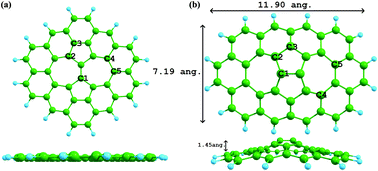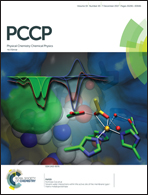Gas adsorption efficacy of graphene sheets functionalised with carboxyl, hydroxyl and epoxy groups in conjunction with Stone–Thrower–Wales (STW) and inverse Stone–Thrower–Wales (ISTW) defects†
Abstract
The complete reduction of graphene oxide is difficult to achieve, and hence oxygen-containing functional groups do exist in graphene, along with structural defects. On the other hand, efficient gas sensor materials have been a subject of relentless interest. This instigates the need to explore the gas adsorption on STW and ISTW defective graphene sheets functionalised by –COOH, –OH and C–O–C groups, using density functional theory calculations. Both defects are experimentally feasible as evident through their formation energies. Furthermore mono-functionalisation induces significant buckling of the sheet; in contrast, bi-functionalisation of the sheet restores the planarity of the sheet. We found that the ISTW defective sheet is more reactive than the STW defective sheet to all the functional groups considered, and in particular –COOH is the most adsorptive group to both the defects, while epoxy has consistent adsorptivity towards the defects. Gas molecules such as CO2, H2, N2, CH4 and O2 are physisorbed, whereas HF and H2O are chemisorbed on the functionalised sheets. The sensitivity of the gas molecules towards the functionalised sheets is obtained by ΔEg, which is pronounced for pristine + OH and STW + epoxy and bare ISTW defective sheets. However, the functionalised sheets exhibit improved sensing properties for O2; specifically, mono-epoxy functionalised and bi-carboxylated defective sheets show high sensitivity towards O2. Furthermore, the surface functionalisation enhances the selectivity of the sensor. From the TDOS plot, the functionalised sheet exhibits p-type behaviour. Thus, the results of this study reveal that the functionalised defective sheets can be utilized as O2 sensors.



 Please wait while we load your content...
Please wait while we load your content...